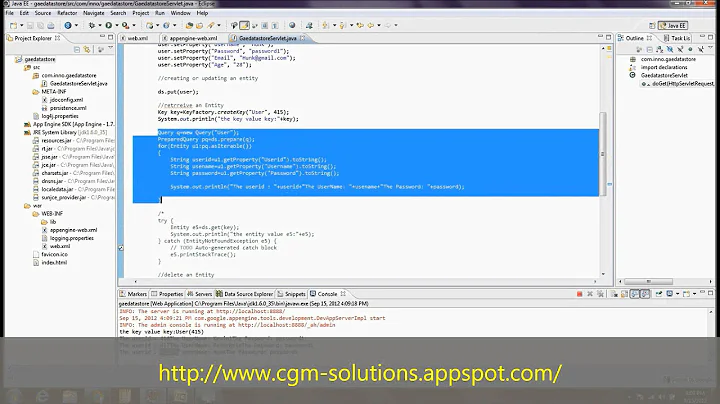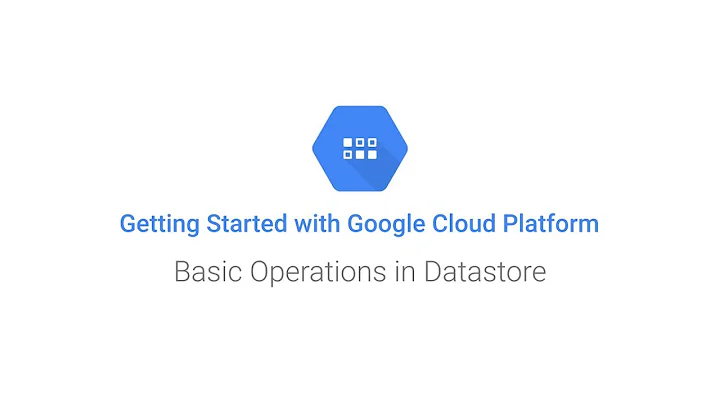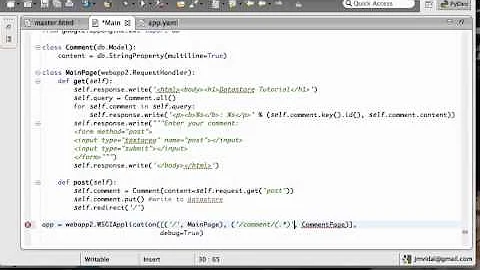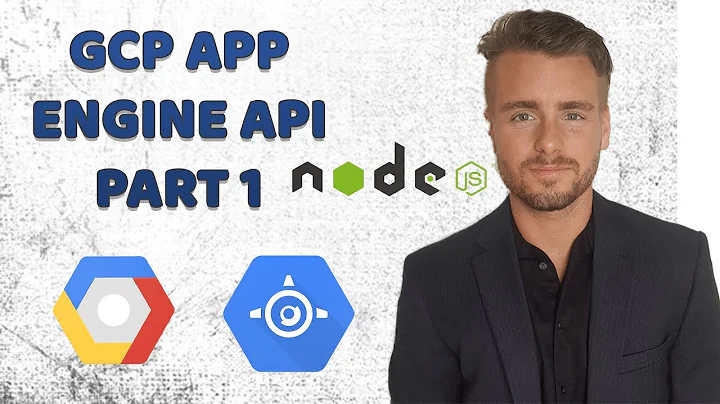How to browse local Java App Engine datastore?
Solution 1
http://googleappengine.blogspot.com/2009/07/google-app-engine-for-java-sdk-122.html: "At long last, the dev appserver has a data viewer. Start your app locally and point your browser to http://localhost:8888/_ah/adminhttp://localhost:8000/datastore* to check it out."
* as of 1.7.7
Solution 2
There's currently no datastore viewer for the Java SDK - one should be coming in the next SDK release. In the meantime, your best bet is to write your own admin interface with datastore viewing code - or wait for the next SDK release.
Java App Engine now has a local datastore viewer, accessible at http://localhost:8080/_ah/admin.
Solution 3
I have local datastore on my Windows+Eclipse environment on \war\WEB-INF\appengine-generated\local_db.bin
As far as I understood it uses internal format named "protocol buffers". I don't have external tools to present the file in human-readable format.
I'm using simple "viewer" code like this:
public void doGet(HttpServletRequest req, HttpServletResponse resp)
throws IOException
{
resp.setContentType("text/plain");
final DatastoreService datastore = DatastoreServiceFactory.getDatastoreService();
final Query query = new Query("Table/Entity Name");
//query.addSort(Entity.KEY_RESERVED_PROPERTY, Query.SortDirection.DESCENDING);
for (final Entity entity : datastore.prepare(query).asIterable()) {
resp.getWriter().println(entity.getKey().toString());
final Map<String, Object> properties = entity.getProperties();
final String[] propertyNames = properties.keySet().toArray(
new String[properties.size()]);
for(final String propertyName : propertyNames) {
resp.getWriter().println("-> " + propertyName + ": " + entity.getProperty(propertyName));
}
}
}
Solution 4
In the newest versions of the SDK (1.7.6+) the admin part of the dev server comes with it changed its location
Analyzing the server output logs we can see that it is accessible at:
http://localhost:8000
And the Datastore viewer:
http://localhost:8000/datastore
Looks pretty neat - according to google's new design guidlines.
Solution 5
Open the \war\WEB-INF\appengine-generated\local_db.bin file with a text editor, like Notepad++.
The data is scrambled but at least you can read it and you can copy to extract it.
Related videos on Youtube
Jim Blackler
I'm a software engineer with nearly 20 years commercial experience, and as a hobbyist even longer. I currently work for Google, before that you could find me in the videogames industry. I specialise in user-facing technology; browser and mobile handset applications.
Updated on December 25, 2020Comments
-
Jim Blackler over 3 years
It seems there is no equivalent of Python App Engine's _ah/admin for the Java implementation of Google App Engine.
Is there a manual way I can browse the datastore? Where are the files to be found on my machine? (I am using the App Engine plugin with Eclipse on OS X).
-
Paul almost 15 yearsNew admin interface is still not working with kinds/entities created by Native Datastore API. So I still need my "viewer" :)
-
Nick Johnson over 14 yearsYou mean the link to the blog post that was posted several days after I posted this reply? 'outdated' I'll accept, but redundant and voted down is a bit cruel.
-
mcherm over 14 yearsI agree. Good answer at the time; now outdated.
-
Chad Gorshing almost 14 yearslocalhost:8888/_ah/admin worked like a champ for me (note the port changed) - but I will try out the AppWrench just for comparison.
-
SunnyD over 11 yearsThank you so much! I really needed this to debug a persistence issue.
-
 Timo about 10 yearsThe code is good, but the parameter for the query constructor is wrong: Table is not correct, it mus be the Entity name. In the guestbook example it would be "greeting" which is the row. I tried this, but not working:final Query query = new Query("Guestbook/Greeting"); Another issue: How do you show the content of different keys/names of a table with your code? Like guestbook1, gb2, etc.
Timo about 10 yearsThe code is good, but the parameter for the query constructor is wrong: Table is not correct, it mus be the Entity name. In the guestbook example it would be "greeting" which is the row. I tried this, but not working:final Query query = new Query("Guestbook/Greeting"); Another issue: How do you show the content of different keys/names of a table with your code? Like guestbook1, gb2, etc. -
 Johnny almost 9 years@mcherm this one worked for me. The other answers here, on the other side, didn't.
Johnny almost 9 years@mcherm this one worked for me. The other answers here, on the other side, didn't. -
 Pini Cheyni about 8 yearsThis code looks for all your entities and their child entities, what if the child entities have children too ? will this function run as recursion ?
Pini Cheyni about 8 yearsThis code looks for all your entities and their child entities, what if the child entities have children too ? will this function run as recursion ?

![App Dev - Storing Application Data in Cloud Datastore - Java | Qwiklabs [GSP167]](https://i.ytimg.com/vi/6KBe0fQB1Kk/hq720.jpg?sqp=-oaymwEcCNAFEJQDSFXyq4qpAw4IARUAAIhCGAFwAcABBg==&rs=AOn4CLB2HZYlanY-1-mJLzskX1HnuQrOZg)








